A Digital-First Paper Anniversary: The First Year of Braze Magazine and Perspectives, As Told by the People Who Built It
Published on July 09, 2019/Last edited on July 09, 2019/28 min read


Team Braze
Great customer engagement requires great data, technology, and teamwork. It’s true for marketing, growth, and engagement teams in every region and every vertical, and it’s just as true when it comes to marketing efforts here at Braze. Over the past year, Braze has embarked on a major initiative that has drawn on Agile frameworks, inspiration from traditional print media, Braze proprietary data, and more to reimagine our content experience and the systems supporting it in fundamental ways. To mark the one-year anniversary of the launch of our Braze Perspective digital content hub and the first print edition of Braze Magazine, we’re taking an exclusive look at the data, tech, and teams that made it all possible.
Prehistory: Before Braze Was Braze
In the fall of 2017, a six-year-old software startup called Appboy was gearing up for a pivotal moment in its history—a complete rebrand of the company that included a name-change. Starting November 16, 2017, Appboy would become Braze. And as all those preparations were in the works, the Braze Content team started thinking about what these major changes meant for the company’s approach to content.
Todd Grennan (Managing Editor, Content Marketing at Braze): The seeds of Braze Magazine and Perspectives were sown in the lead-up to the rebrand, as we were building out the new Braze website, and figuring out what the look and feel of this new brand were going to be like. I was told that we were going to be deprecating Appboy’s RELATE blog, which had been the center of our digital content experience up to that point, and that we were going to need to come up with a plan to replace it with something that was a better fit for the company we were going to become.
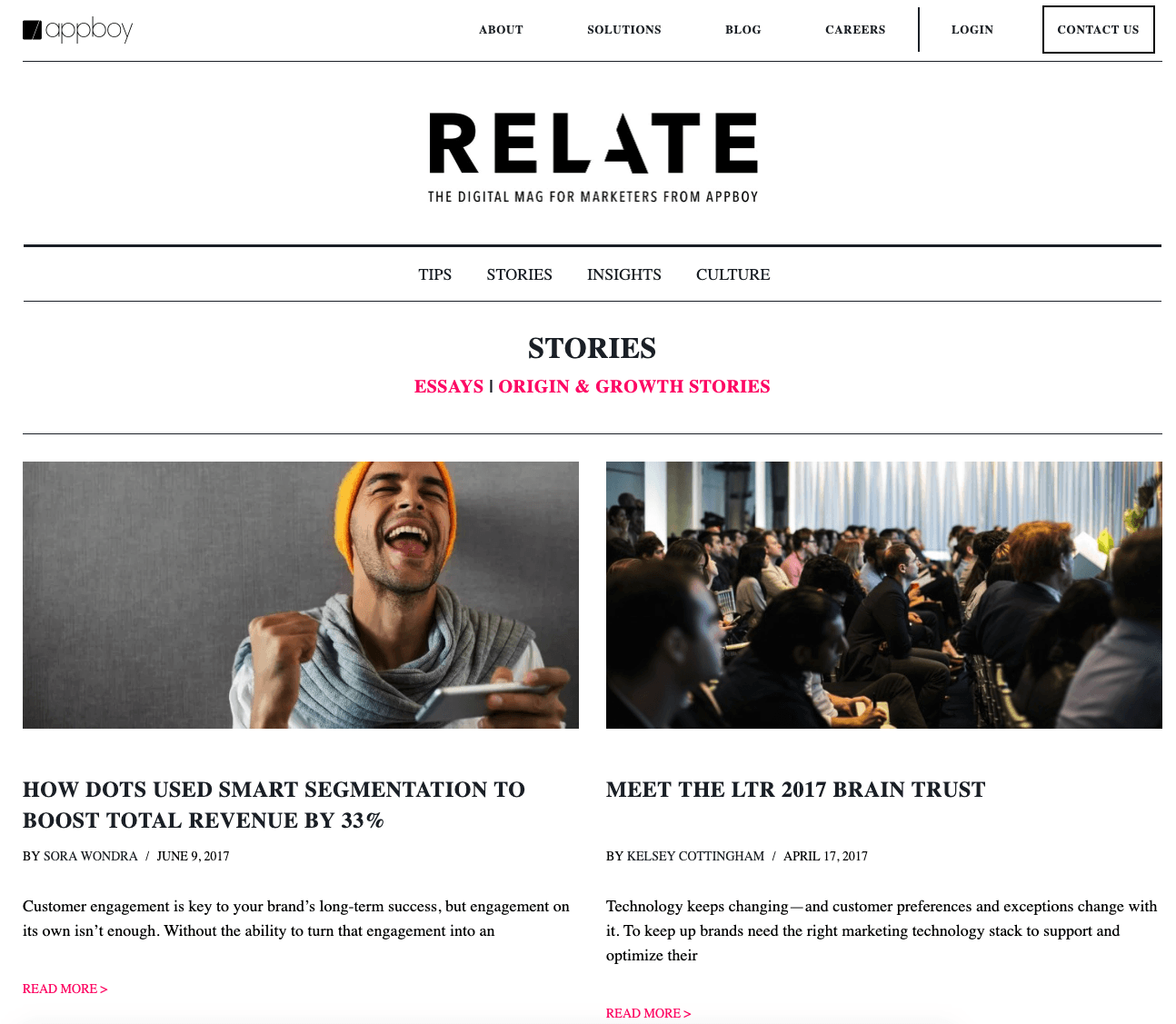
Jane Grenier (Creative Brand Storyteller and then–Content lead at Braze): Our mission when we started in on this project was to accomplish a number of things to keep going the strong SEO fuel that was a critical part of the Appboy blog experience while taking a leap forward in terms of user experience, as well as the nature of some of the content really becoming more ambitious in the formats that we tackled with work that we produced.
Grennan: The old blog was really limited in what it could support, in terms of experiences beyond text. It could do some basic image inclusion, but doing things like videos was a struggle. Interactive experiences were, basically, I don't want to say, “impossible,” but we certainly never did it.
Grenier: All this happened to dovetail with a complete rebrand of the company, which was both an opportunity and a challenge as it gave us somewhat of a clean-slate moment, but it involved a heavy lift on multiple fronts by the whole of the marketing team.
Grennan: It wasn't exactly a blank slate…but it was an opportunity to think, “Okay, what is our ideal content experience given the need to support interactive experiences, a more visual look, and a more mature approach? And how do we make that experience actually happen on a day-to-day level?”
Kelsey Cottingham (Editor, Content Marketing at Braze): When I started at Appboy [in January 2017], our content was far more blog-focused and it was more of just a constant stream. I wouldn’t say it had no rhyme or reason to it, but it was very ad hoc...And when your entire content program is a little more ad hoc, it makes it more challenging to prioritize a certain thing just because it is a piece that we agreed would go up. It’s easier for things to fall off, or potentially to go up when they’re not quite ready because we’re trying to hit a certain number [of posts per week], rather than focusing on putting up a really quality piece of content.
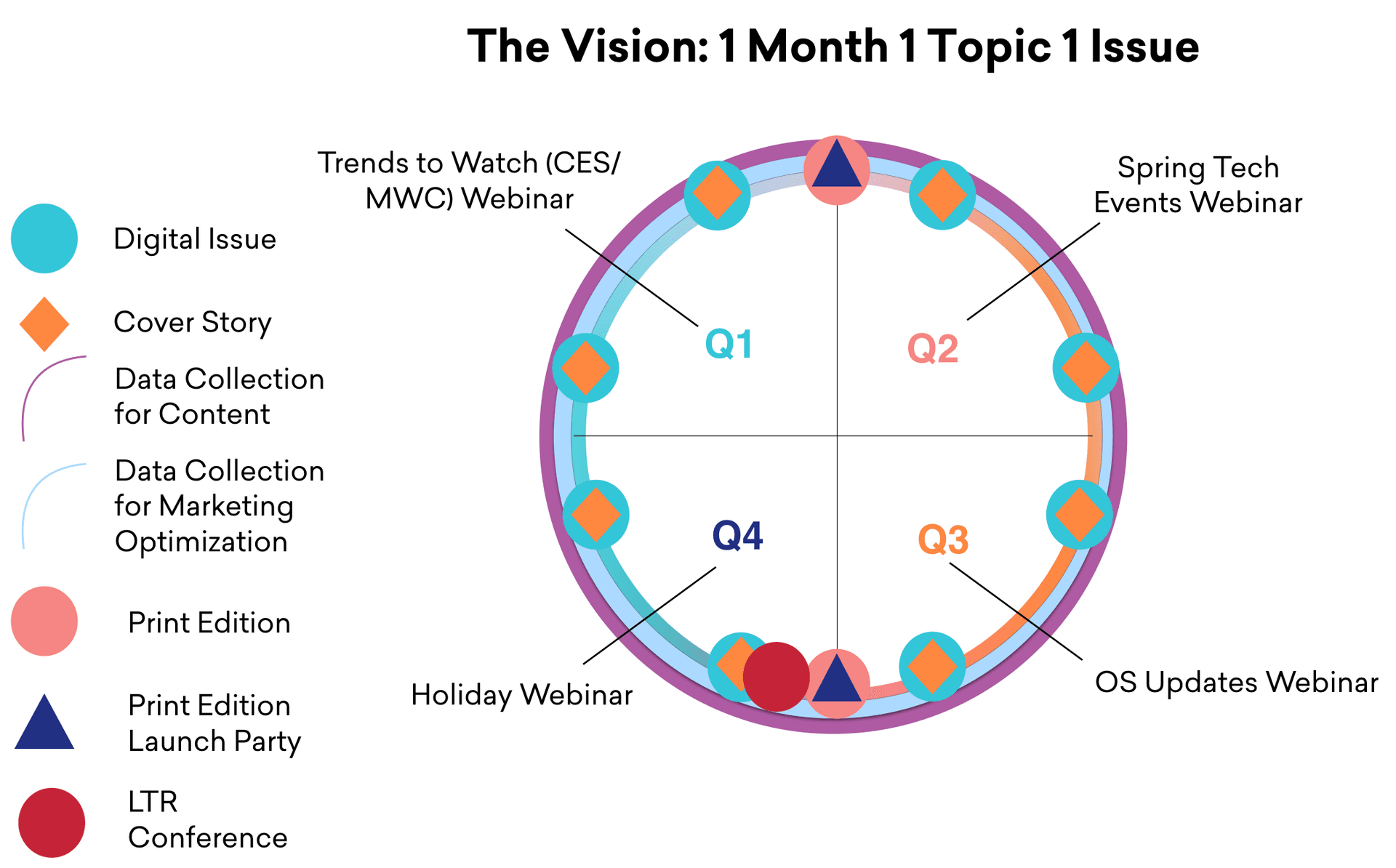
Grennan: I've learned a lot here, in this job, about figuring out how to make things run more smoothly. We've often been a relatively small team, and have needed to do a lot of things efficiently and well. I didn't think we could elevate [this new content experience] as much as we wanted to, or were looking to, unless we figured out a way to avoid distractions, and things that were burning time back then. We couldn’t really afford those issues if we were going to be doing something a lot richer and more complex. I basically went in trying to be like, “What could we do that would elevate this? How can we build a system around that goal of editorial calendar, a system of processes, an approval process that allows us to have time to work and do these more involved things and do them really, really well?”
Gearing Up: Building a New Content Approach
Following the rebrand, the Braze Marketing team aligned on a new content approach. To build consistency into the editorial calendar, each quarter would see the team publishing two separate seven-article content bundles—known as “issues”—on topics approved by the company’s executive team, along with an always-on flow of blog content.
Grennan: As we first started building this initiative, there were kind of a few main tentpole things we were having to do. We were having to basically switch to a monthly magazine approach, create a new section of the website to host and elevate the content we’re planning, and build out a full editorial calendar for the first time…[to] make it possible for us to plan a quarter in advance for most of the content we needed to create.
Cottingham: That was a crazy time. At first, the thought of like planning out a whole quarter ahead, every piece of content that we would do sounded impossible. Not because we weren't capable of it, but because of the legacy of how we had created content before.

Grenier: I think that one of the benefits of the magazine format is a very strong scaffold that supports a consistent content production engine, always moving no matter what else is going on. This is a skill that builds with time. One can do all the advance planning in the world, but stuff happens. Right? Shift happens, as we say at Braze. If your plan is strong, it's also resilient and there's room to accommodate other priorities or to change the plan to achieve new objectives or to alter tactics while retaining that same angle. There's a lot of flexibility that can be found even within the strong kind of editorial calendar structure that we've built.
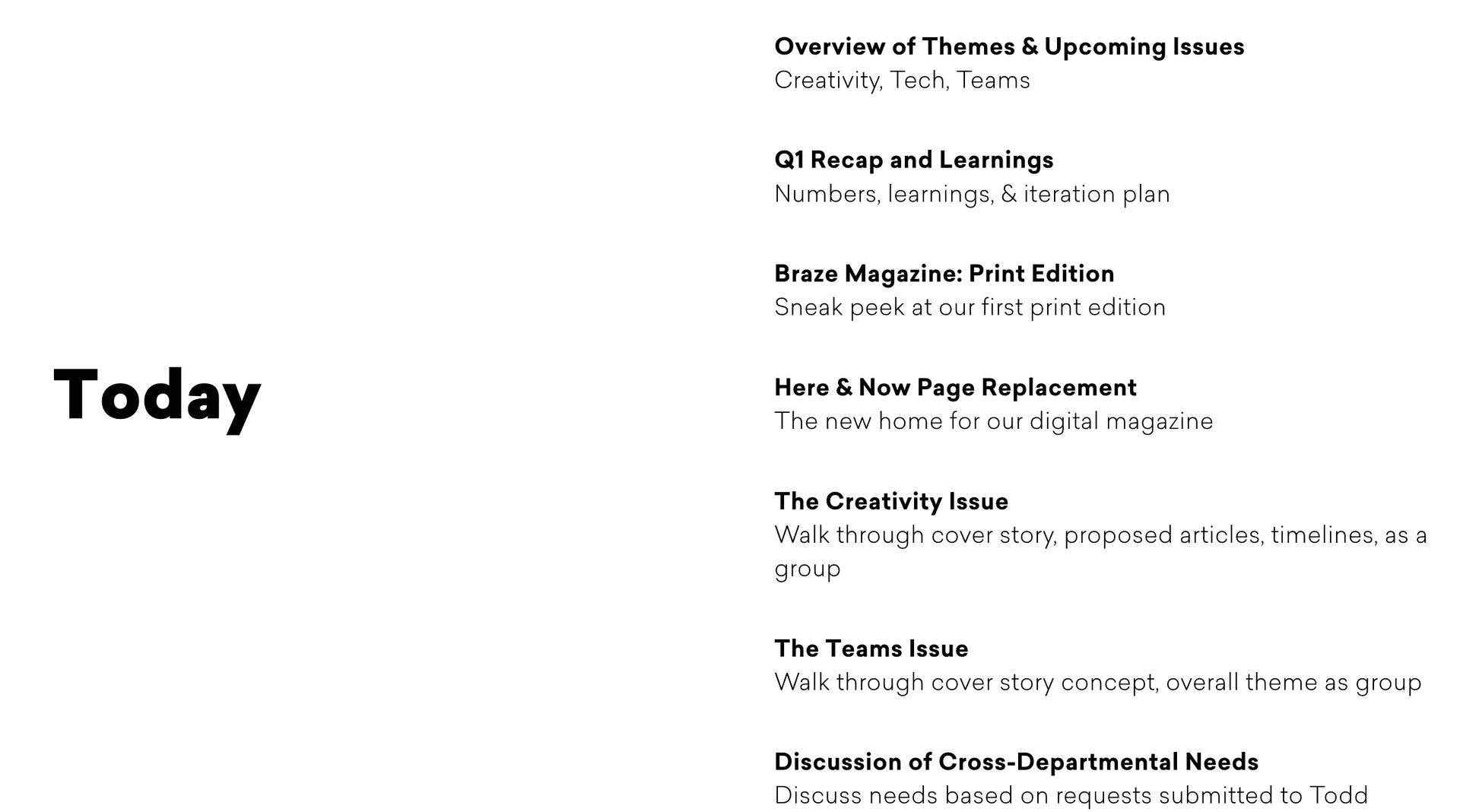
Grennan: To make sure we actually were aligned with other departments and other teams, we created a quarterly cadence where we’d meet with representatives of all the client-facing and prospect-facing departments and we’d present our content plan for the next three months. We’d solicit feedback, talk through content—and get people on the record about what their department or their team actually needed, content-wise, for the upcoming quarter.
Cottingham: [One key was] getting stakeholder buy in from around the company, not only to ensure that people in different departments had the opportunity to give input and understand what we were doing so they wouldn't ask us to do new things, but also so that we actually got their input so that product and sales and customer success or whoever else would have some input and feel a part of the content program…[it] was pretty huge for us.
Braze Magazine’s Soft Launch: From the Blog to Perspectives
The Content team launched their editorial calendar in January 2018 and started making plans for the four digital issues and coming up in the first half of the year. But because the new content platform that was intended to host Braze Magazine was still being sketched, the first two issues were published on the company’s existing blog, with plans to migrate them over when the site went live.
Cottingham: [We knew] Perspectives needed to be as pretty as it was functional. It needed to have a lot of capabilities that our old blog did not have. And we would meet once a week with [branding and web design agency] Focus Lab to go over the progress we were making with the site’s development and talk through everything...where it was, and aligning on priorities across the Marketing team in terms of what was a nice-to-have versus a must-have. For instance, having support for infographics and audio and interactive experiences or prioritizing the site’s search functionality... And then how do we use our own technology to help? How do we engage with people who really like our content? And that's where we came up with that pop up that says "You love us, you really love us," with our little mascot, which we affectionately call Torchie.
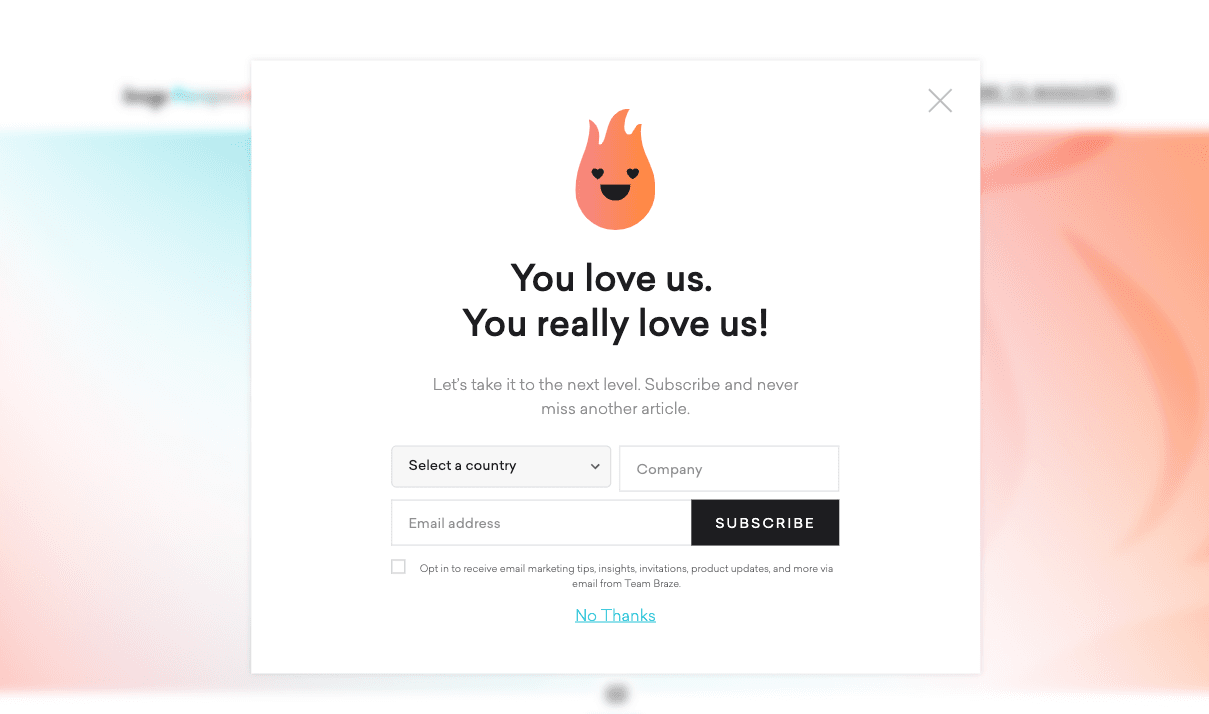
Grenier: The topic of our first issue [The Security Issue] was another great synergy moment. Choosing to anchor the issue in security at the moment when GDPR [the EU’s General Data Protection Regulation Regulation] was the sun rising above the horizon, shining a spotlight on all kinds of things, well, it gave us an invaluable platform. And there was nothing arbitrary about that decision. It was a moment in time when Braze could seize the moment and own “security” before other companies in our space did. The fact that we were doing it as a multi-part package of content let us come at the subject matter from different directions. From the legal angle, obviously, from the CTO’s perspective, but then also from more creative points of view. I don’t think we would have thought that way if we weren’t operating within this issue framework.
Cottingham: That one really stands out to me. It was the first and it got done, but boy did it have some complex pieces in it, both creatively and also just in terms of needing to be especially accurate because there was going to be such a lens on it. And it was a really interesting experiment, to have to get so much buy-in from so many people…[it’s] just such a complex and big topic, and involved Jon [Hyman, Braze cofounder and CTO] and Susan [Wiseman, SVP, general counsel, and corporate secretary at Braze] and even reading our third-party auditor’s materials and getting buy-in to do an entire fictional story about all the ways companies can mess up GDPR.
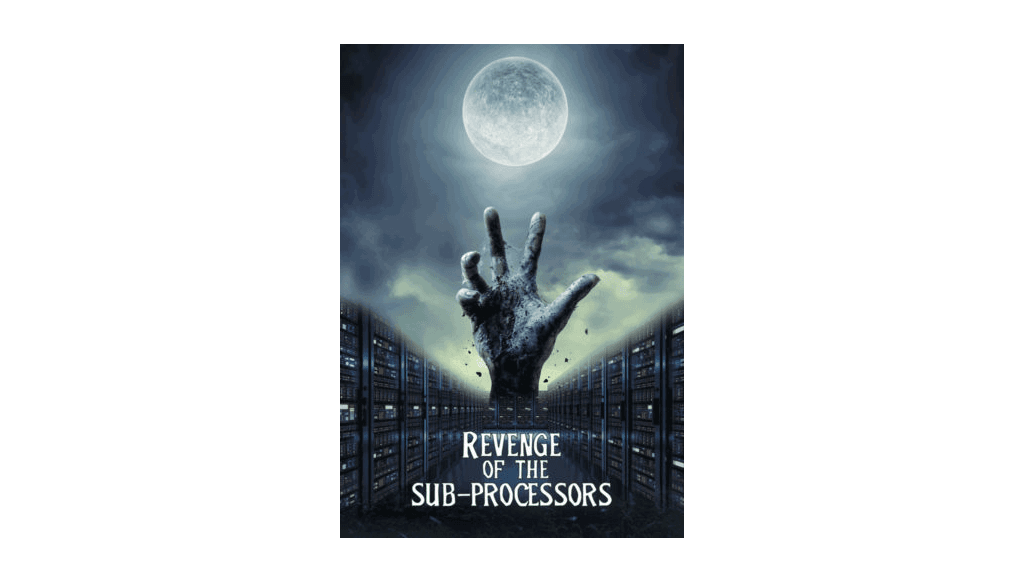
Grennan: "Friday the 25th" is our horror-fiction takeoff, a short story about the first day of GDPR enforcement on May 25 [2018]. The process of getting to use my creative writing degree a little bit in a work setting was novel for me and I was just so jazzed about the work that our Creative Studio Team did for the visuals, especially the giallo-style horror movie posters that break up the different sections of it…[but it also] showed us that we could take a really ambitious, content-forward, innovative approach and have the piece do well, be meaningful, tell the story it needed to tell. It was validation that we didn’t have to limit ourselves to listicles and whitepaper-ish deep dives on the content front. And I’m proud of the work we put into it, but I’m also really proud of the department and the company for letting us have the freedom to try out these things.
Cottingham: [Next was] the Intuition Issue in April. That one was all about AI and data—and that’s the one where we didn’t realize until we were three-quarters of the way through that the reason we were so overwhelmed was because we had accidentally included like nine pieces instead of the usual seven. Plus, half of those were either infographics or interactive.
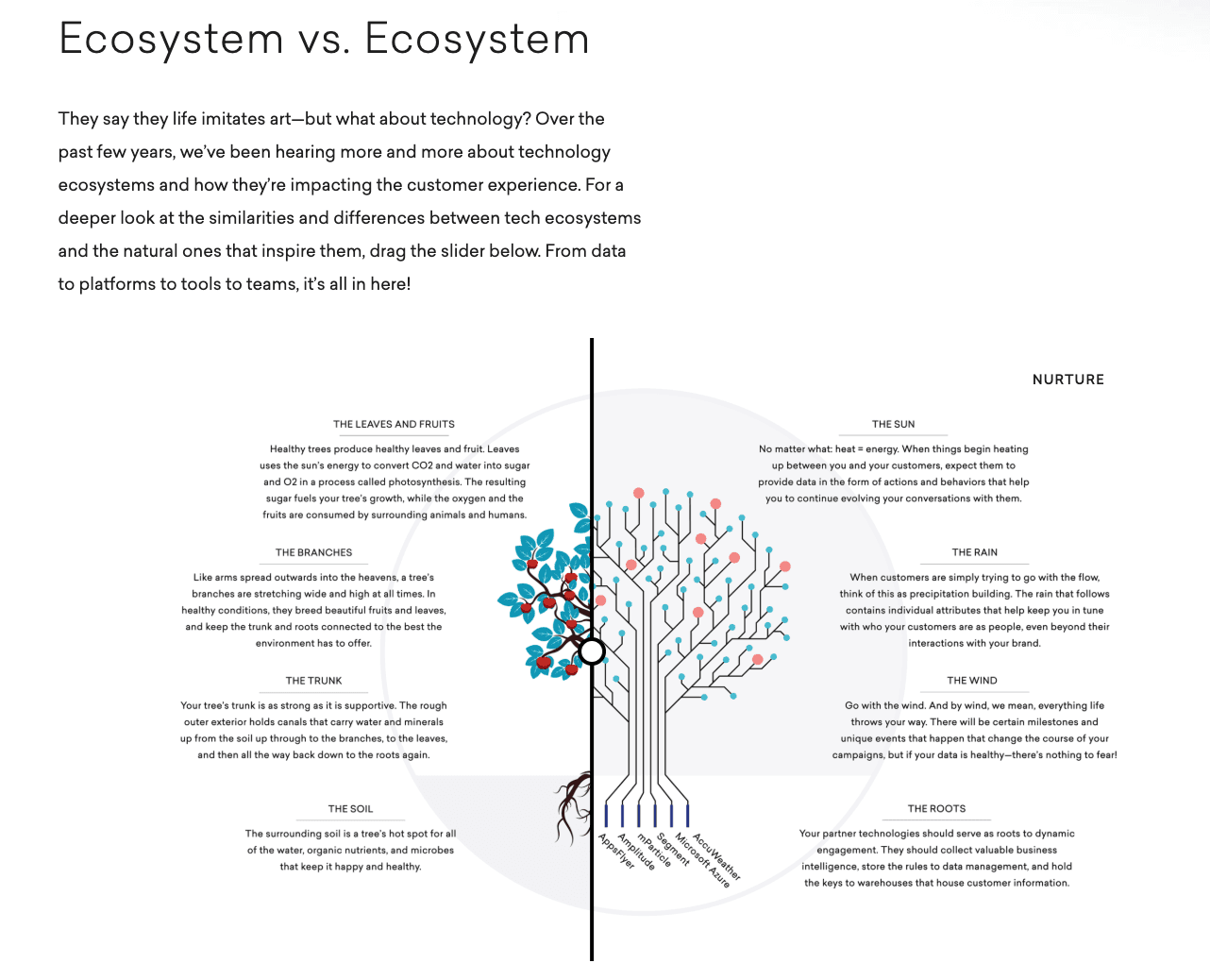
Grennan: There’s being ambitious and then there’s being over-ambitious. The Intuition Issue turned out pretty well, but we definitely learned a lesson on that one about scoping an issue before we kick it off.
Grenier: Sometimes we had to really wrestle with our own content technology to ensure that our clients and prospects could have the experiences, the rich, immersive experiences, we wanted to provide, but it was a noble battle. We live in a time when humans increasingly respond to images and sight, sound, and motion, and interactivity, so it's critical that we can communicate our value proposition in those sorts of immersive ways beyond the text.
Cottingham: We didn’t tailor our ideas down, and we didn’t realize until too late in the process that we had kind of bitten off more than we needed to chew...it was really challenging and required us to work really closely across the Marketing team and required a little bit of heroic effort from some of teammates to get it out there, but it resulted in some really great pieces that still see solid engagement. And we still pull out so many of those pieces today when we talk about [the Braze] Intelligence Suite or AI in general.
Grenier: With Intuition, we were thinking about creativity and our first major foray into the Cannes Lions Festival of Creativity. That gave us a very different framework that also lent itself to a package of content. [Overall,] those two issues were our proof of concept for the packaging of a bundle of like-themed content. The strong performance of those issues proved our point, I think.
Back to the Future: Embracing the Physical with Braze Magazine’s First Print Edition
While things moved ahead on the digital front, the Braze Marketing team took steps to explore a new (yet old) content platform—print. In order to get their content in front of new audiences and to reduce the need for ad hoc printed assets for conferences and client/prospect meeting, the team decided to publish two print editions each year, one in the spring and one in the fall.
Grennan: The print edition experience has been all learnings the whole way through, basically. We were really lucky, when we kicked this off, that we had some people on the team, Jane Grenier, in particular, who had a lot of print experience. But it really was a moonshot, big bet, for us, because we'd never done a print publication more ambitious than say, a one-pager, or a printed brochure.
Grenier: To me, with my background in traditional, old-school media, most of my career spent in the then magazine business before digital was a thing, I felt like the print magazine was a coming home moment. I deeply understand what it takes to put together a tangible asset like the print magazine, and I have a strong sense of its value as a branding tool…[plus,] there’s something about building toward a tangible asset that brings a team together in a different kind of way. When you ship something to a printer, you're done. It's not like, "Hey, Todd, I noticed a word missing" and we can fix it on the fly. When print is done, it's done—for good or ill.
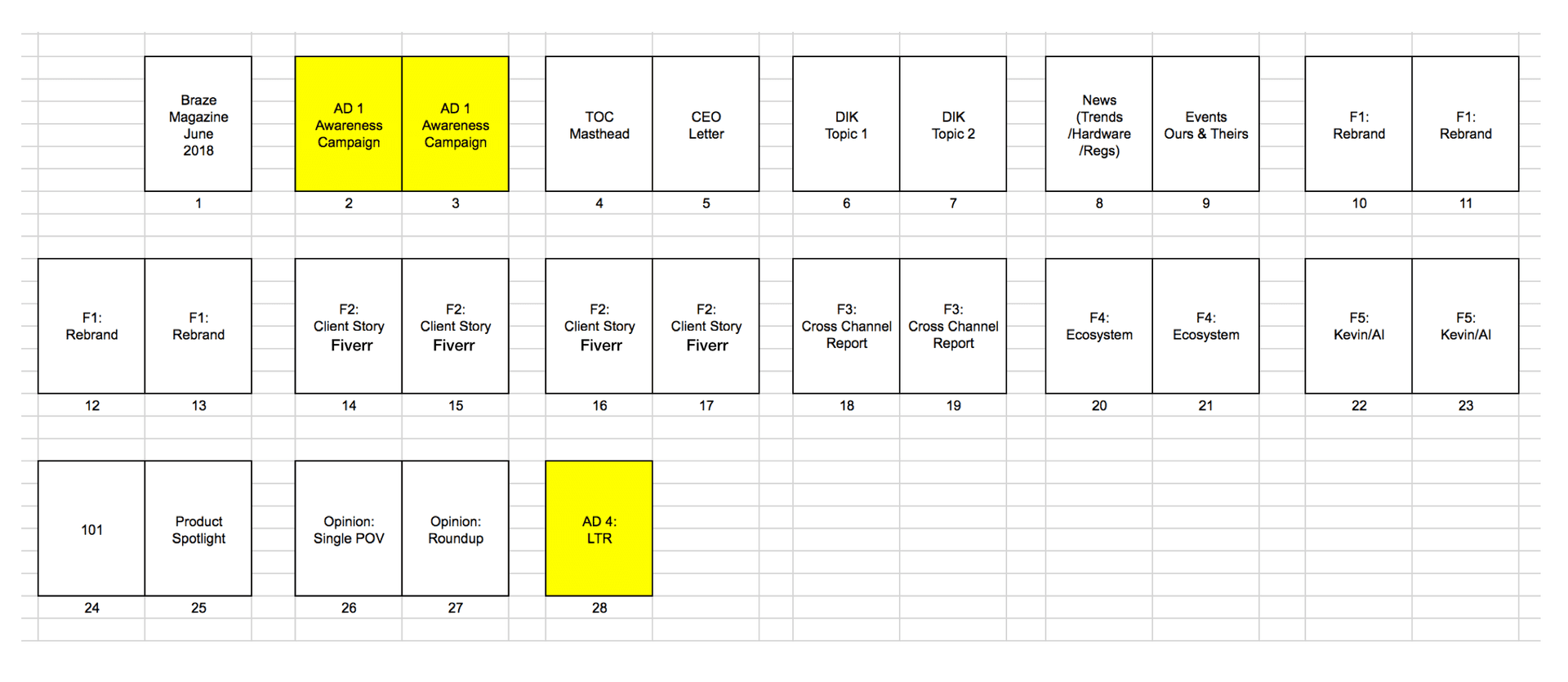
Alejandro Santandrea (Creative Director at Braze): My first few months here were very fast and furious, but it was super exciting because, in my prior roles, I had been very interested in trying to do a tabloid based newspaper for branded content, and so now actually they had the green light, but then it was like "Okay, now what do we do?"...And interestingly enough, as part of my interview process, one of the test cases or projects that I was given was doing a print edition. So, coming into the role, I had already thought through a little bit of what I would do, and even the format, even the tabloid size paper.
Cottingham: I can remember like debating a paper, oversized tabloid-style, versus like a glossy smaller magazine, and so many different decisions that went into [the process] that I never even would have realized. And learning all the print terms like “dek,” which is spelled D-E-K and which I think means “subhead” in my language.
Santandrea: Something I’ve been doing a lot over the last couple years is just really using Instagram as a visual discovery tool, because year-over-year, they seem to be surfacing like-minded feeds. And so as soon you slot a few different illustrators into your feed, all of a sudden other great ones start getting promoted...that’s how I found our first illustrator, Magdiel Lopez. He’s a young illustrator who’s done some published work but mainly just does Instagram.
Grennan: We had a client come up to us at LTR [Braze’s annual conference] who was from South America, and she was like "Oh my god, this guy is one of my favorite artists, how did you get him?"...It was like he was a rockstar to her.

Cottingham: I kind of remember when we plotted it out, working with our creative director Alejandro, who had some magazine and newspaper-type experience, and when we got the table of contents and saw what the spread would look like—we’d sourced illustrators—and I remember the first time we saw the artwork, I think our jaws kind of dropped a little bit. Like, oh my gosh, this is happening. It's going to be a real thing. It's going to be beautiful.
Grennan: That experience of doing that first print edition, where we had never done it before was a really great bootcamp experience for the Content team—in that we basically had to be incredibly buttoned up. We had to build on our processes to be able to ensure this went out on time and on budget without obvious typos or other issues. And I think we rose to the challenge, but it was a real struggle, especially in the final weeks, where you're just proofing for hours.
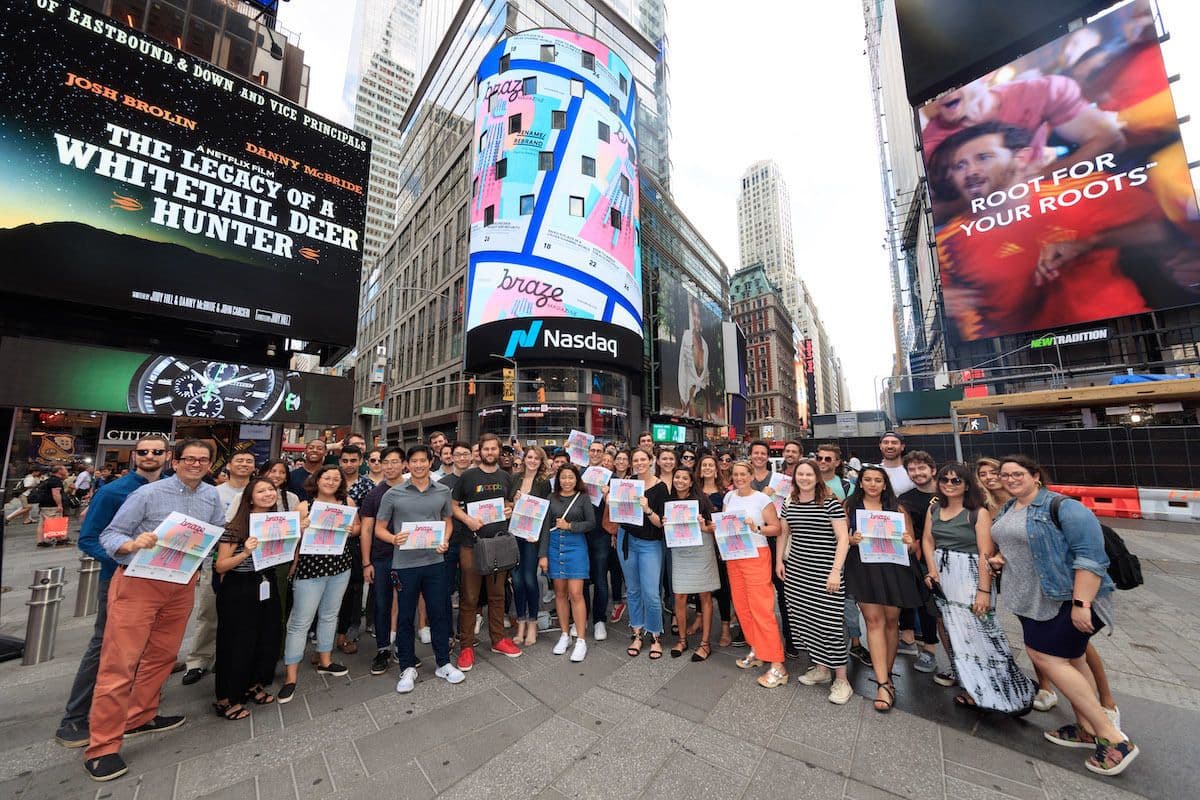
Grenier: On the ground at Cannes, it was wonderful to see the brand presence, the literal presence in the hands of the influencers in that important spotlight moment and showcased in multiple venues where the greatest strategic and creative minds of the business were circulating to see it. In a less airy kind of a way, it's wonderful to see those people on the go-to-market team who've had light bulb moments of saying, "I can use this across the desk with a customer or prospect and bring our capabilities and brand to life in a way that an email just can't do."...I think that the print magazine will continue to grow in usefulness over time.
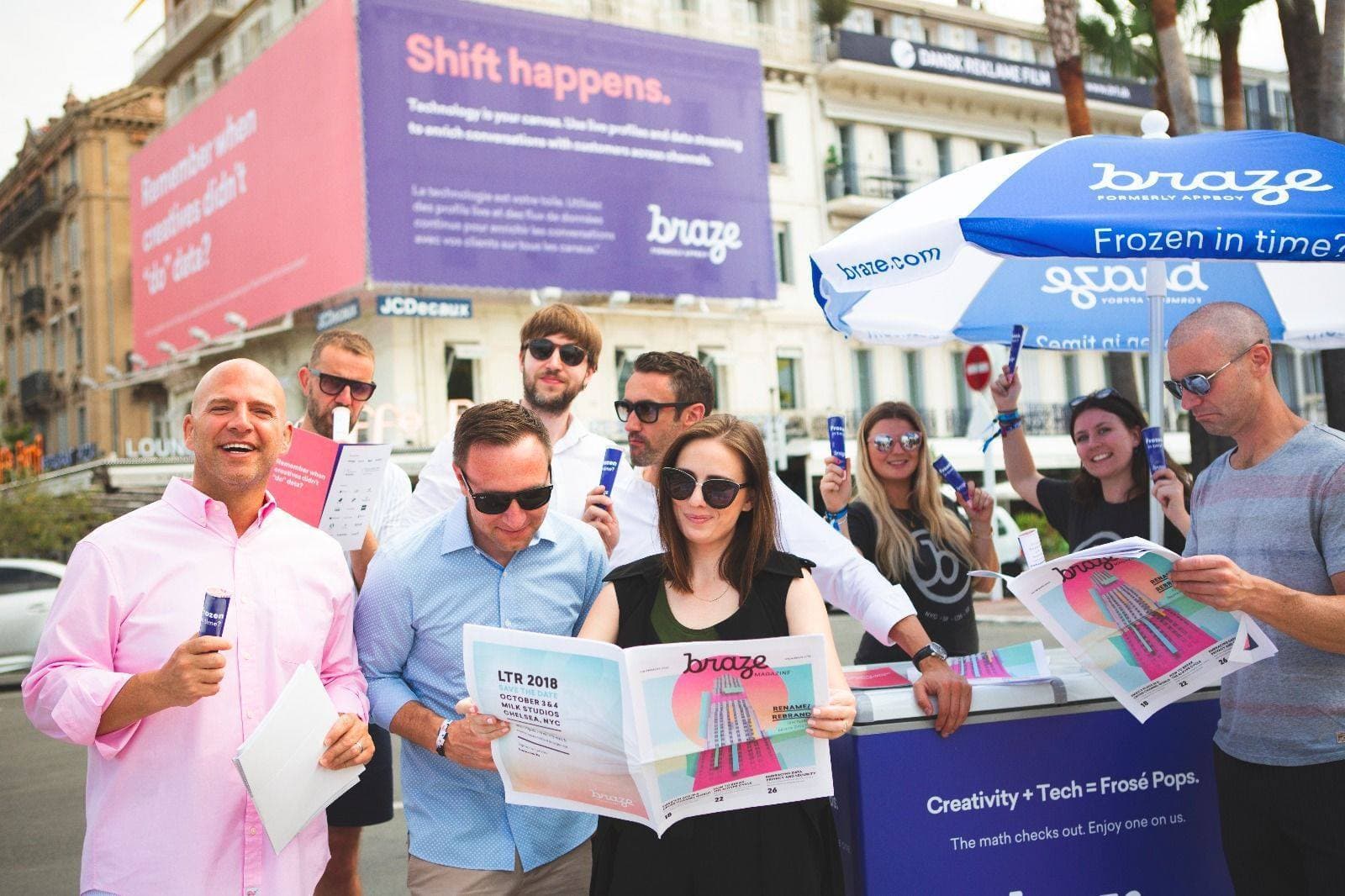
Hello, Perspectives: Launching a New Site and a New Sub-Brand
In tandem with the launch of the first Print Edition, Braze Magazine published its first issue on Perspectives in June 2018, marking the first time that the Marketing team’s new content initiative had been implemented in full.
Grennan: We wanted Perspectives to be rich and interactive the way a lot of tech sites are, but also to have the elegance and clarity you often get with magazine websites...Having this built-for-purpose content experience makes it possible for our readers to curate their experience more. By breaking out always-on content and themed issues, people can make the affirmative choice to look at what’s most recent, or they can go back and dig into areas of specific interest for them. Because the design’s a lot clearer, it’s much easier for them to do that, and to take control of their content experience.
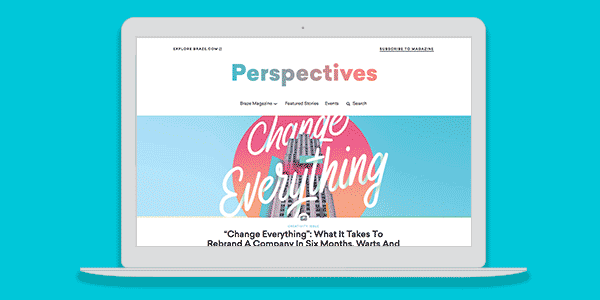
Santandrea: Perspectives was the first Braze sub-brand I had to whip up. And from there, we had a bit of a style guide being applied forward for these public-facing sub-brands, like Braze Alloys, for instance. And for a lot of our other internal sub-brands, we're a little bit looser, we have a little bit more creative freedom, but we are trying to be a little stricter with our stuff, and Perspectives kind of set the tone a little bit for those other sub-brands which is kind of cool.
Grenier: From this side of that big startup period, we accomplished our goal of taking a great leap forward with the Perspectives experience and the content cadence of the issues of Braze Magazine. It gives us useful packages of content that can drive demand gen and little content centers of excellence that the go-to-market folks can turn to based on what their client needs or prospective outreach needs are.
In the Shadow of LTR: The Benefits of Long-Term Content Planning
During the summer and fall of 2018, the Braze Marketing team found itself balancing both its ongoing content operations—including four digital issues of Braze Magazine and a second print edition—with the growing demands associated with that year’s edition of its LTR annual conference, held October 3–4.
Cottingham: It was the cadence and the process we’d created with Braze Magazine that made it even possible at all. We as the Content team were largely tasked with coming up with the content for the conference, and with talking to the clients and prospects and thought leaders who’d be speaking at our conference and organizing those panels. It was no light task, but the only reason they were able to coexist was because there was a process in place...the ability to plan ahead made it as little duplicative work as possible and as livable as possible too, as anyone who's touched a conference knows.
Grennan: It’s a balancing act, running this sort of long-term editorial calendar while you also have short-term things popping in. But embracing the calendar and sticking with it worked. We hit our deadlines, pulled off four digital issues and a second print edition—and one of our most memorable pieces actually grew out of this period.
Santandrea: I think one of the things we all would like to do is to make the most engaging content. And being on the design side, a lot of that manifests itself not only in illustrations, but also in interactivity. I think we did that with the Broken Vs. Brilliant video series, which I think was just great.
Grennan: We knew we wanted to dramatize what a really brilliant customer experience looks like, but also its inverse—a broken experience that just doesn’t work the way it’s supposed to. We went back and forth about what the best medium for that would be; at first, it was going to use the interactive slider on still images. I went off on a trip to the Berkshires and banged out the script for it, and when I came back and consulted with the Creative Studio team, and they were basically like, “We really like this script, but the way you've done it, we can't do any of those things that we've considered before. We have to take a different approach.”
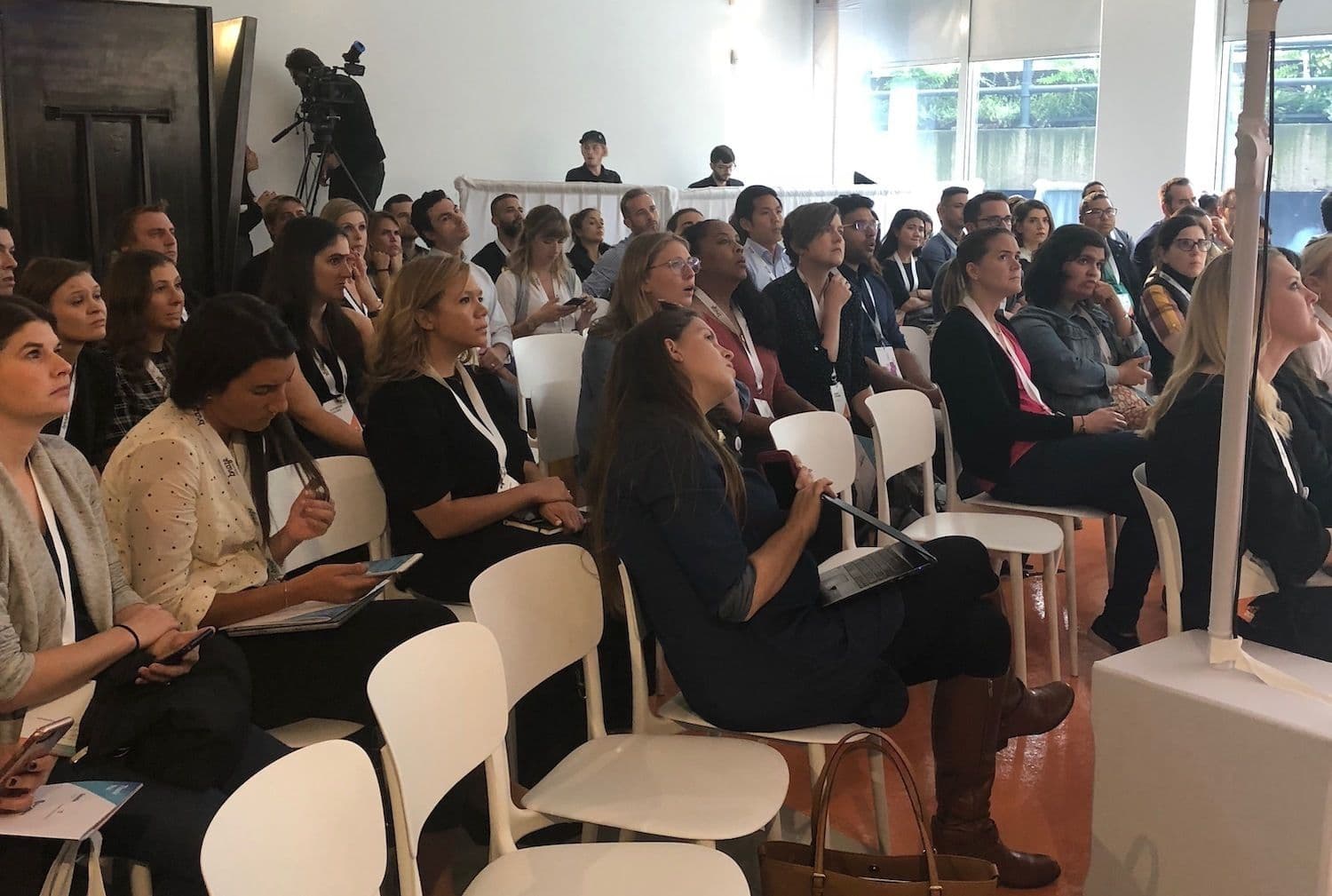
Grennan: Alejandro convinced me that the way forward was using a motion graphics approach. And so, over the course of a month, the Creative Studio team turned the script into eight linked videos telling the story of a fictional customer’s week-long business trip, Sliding Doors-style. All of the push notifications that arrived at the wrong time, or arrived at the right time, in the alternate version. It was definitely harder and more ambitious than I think we initially intended it to be, but it's been so satisfying to see people respond to it.

Cottingham: A big piece for me during that time was our Keeping the Spark Alive article. At Braze, we're all about human relationships and building long term relationships—so getting to take theories of relational conflict and apply them to customer engagement was an interesting way combine two stories that don't usually go together and turn them into something that works. Plus, it was exciting for me to be able to geek out about the five love languages, and the four horsemen, and things like that and relate them to customer engagement.
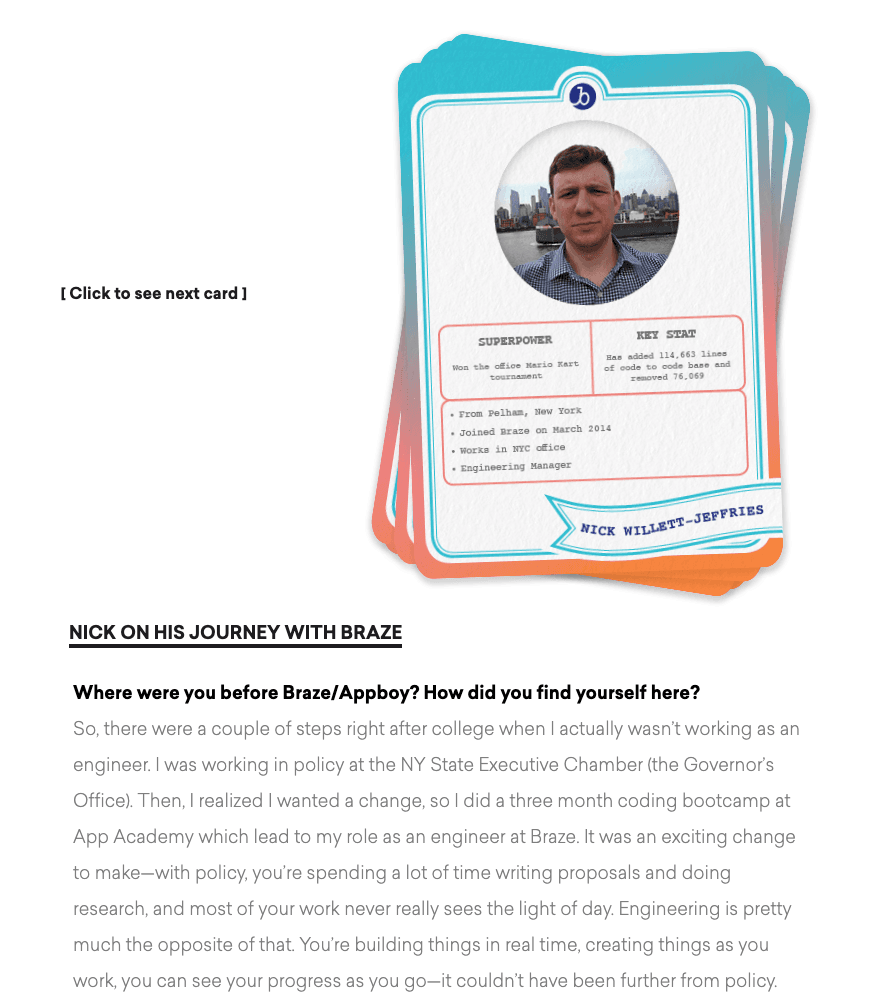
Grenier: Personally, one of the things I’m most proud of is getting our Brazeball Cards article off the ground [during this period] and launching it as a continuing feature. I think it's fun, I think it's a sassy expression of the brand identity, I think it's a great recruiting tool, I think it's a fun internal spotlight, like employee of the month, I think it's a cool thing to look at as a content piece, I think it provided a cool design challenge and opportunity and that's what makes good content appealing, not just to prospects and customers, but to those of us who dig into it on the inside. It's really something to be able to point to something fun and say, "I did something fun, smart, innovative. Our fingerprints are on that."
Big Issues: Pushing Content and Activations Forward with the Conversation and Orchestration Issues
As the Content team’s editorial calendar took hold and content began being published on a predictable, repeatable cadence, the big challenge became finding ways to elevate that content, issue-by-issue—and to ensure that it was getting in front of the right people.
Grennan: I feel like every issue we’ve done has things to be proud of, but the Conversation Issue, that’s one where I think we really nailed what we were trying to accomplish. It has a really inventive interactive experience with Emails on Email, where you’re going inside the inbox to explore what email marketing means today; it has client stories, which are always a major boost to an issue; and it has this great infographic that we worked on with Luisa from Creative Studio, and also with a really talented outside designer, that tells the story of how Braze uses its own technology to support the company’s culture. All the different pieces each have a different focus, and in many cases, a different visual approach, but together they really tell this really interesting story, I think, about how people work together, how technology communicates with other technologies. I think it really was the culmination of a lot of planning we've had about our showcasing Braze culture and the product together in a different way.
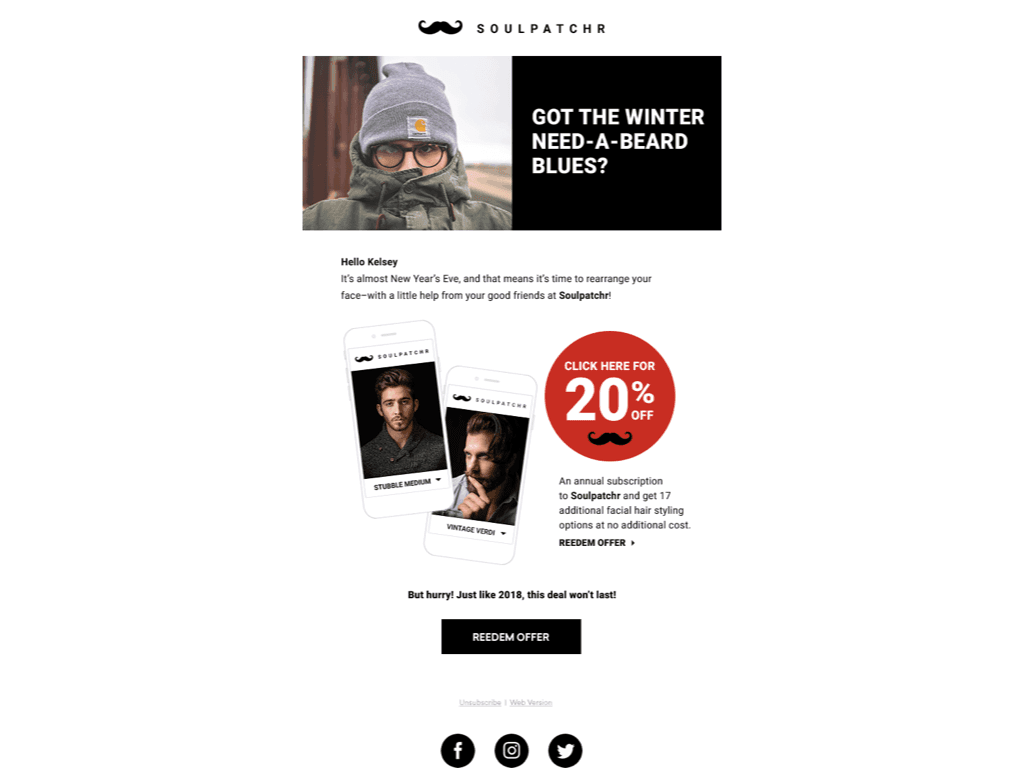
Luisa Fuentes (Art Director at Braze): The Email on Emails piece was the big one. It just contained all these levels of complexity in it—we had to get dev work on it, which doesn’t really happen with a lot of our articles. That was interesting because it means building wireframes within one of our own Perspectives articles to communicate that this is kind of like you’re going through an inbox and seeing somebody’s emails about marketing. And translating that to print later [in the third Print Edition] was a really interesting challenge.
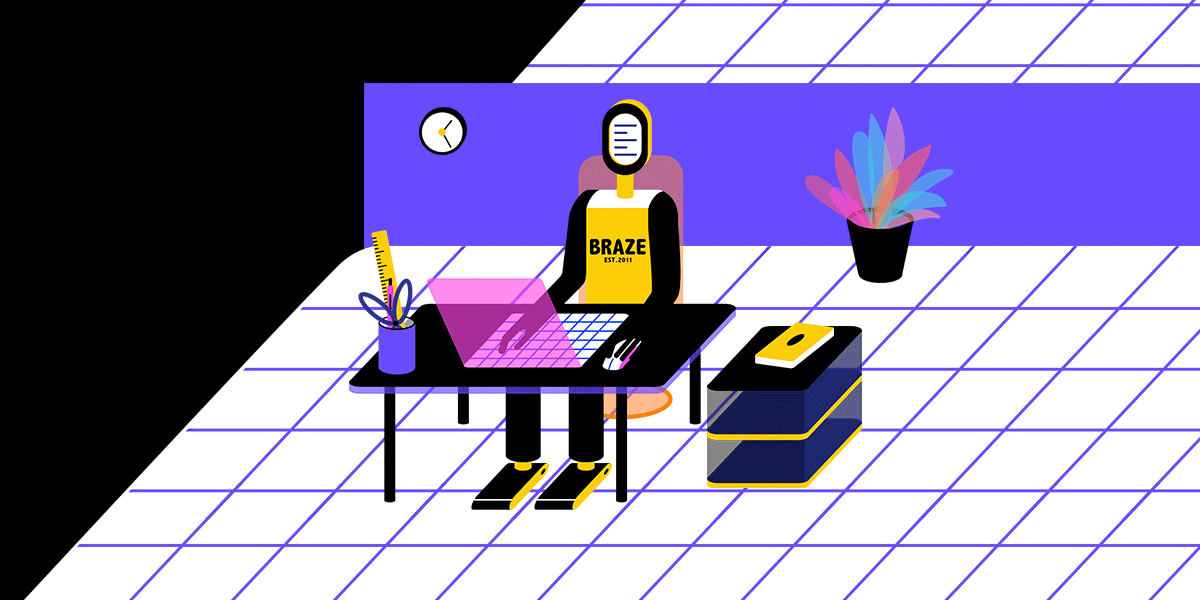
Santandrea: I think the infographic we did for the BrazeLifeBot was really interesting, too. We contracted a new illustrator and liked what she did so much that we’ll likely work with her again on an upcoming article...It was kind of a long scroll infographic. It really tells the story of the creation of the Braze Bot [a Slack bot that announces employee birthdays and anniversaries]. And the content itself if very cultural to Braze in regards to how it kind of represents the Braze life and what it’s like here. And so I think having come to life an illustration is a better way to tell that story perhaps than in another avenue.
Cottingham: For me, our Next-Generation Email article [from the Orchestration Issue] was one that I’m particularly proud of. It was a challenging one because while it was an announcement and a big deal for our company...it wasn’t a new product announcement per se; it was laying out a new way of looking at email. There were a lot of creative and approval challenges and tight timelines. It was one of those pieces where we walked away and said, “You know what, it's terrible, but it's on the page.” And then I came back a day later after some sleep and was like, "Oh, this is actually pretty good." And then other people read it, they're like, "Yeah, it's good." So, that's an example of one that was outside my wheelhouse but ended up being pretty impactful in the company because of the way it turned out and the way that we promoted it.
Grennan: We launched the Orchestration Issue in a really coordinated way with the rest of the Marketing team—taking special care to make sure it could tie into all of the activations and promotions we were doing that month, including an email-focused eMarketer webinar our CEO Bill Magnuson was doing. To watch the numbers roll in for that issue, and to have it become, I believe, our most successful issue to date, was a reminder that this is a long-term project, and that there are more mountains to climb, but also that we're really climbing them.
The Paper (and Brand Humanity) Difference: A Full Year of Braze Magazine
While most of the Braze Marketing team was focused on activating and promoting March 2019’s Orchestration Issue, the Content and Creative Studio teams were busy preparing Braze Magazine’s third Print Edition, which was centered around the research findings contained within the Braze Brand Humanity Index and featured a new visual look and feel. And as the anniversary approached, a couple very pleasant surprises awaited.
Fuentes: Alejandro is very keen on the visuals he wants, and for the third edition of the print mag, it was an interesting challenge trying to find the right type of illustrator. We wanted to have a little bit of a shift from the previous edition and [make it clear] that these are different illustrators. We looked at [a lot of possible illustrators] from this perspective and that perspective to see if they were able to represent what we’re trying to achieve with the print version—and how it speaks to the digital content that’s inspired it. We went through periods of trying to find the right look and feel. That was a process that I’d had experience with [for] a print edition [at an old job], I’ve worked at magazines and stuff like that, but it was a different thing than the newspaper-type content that we do. That whole process was really eye-opening, especially in the context of a tech startup.
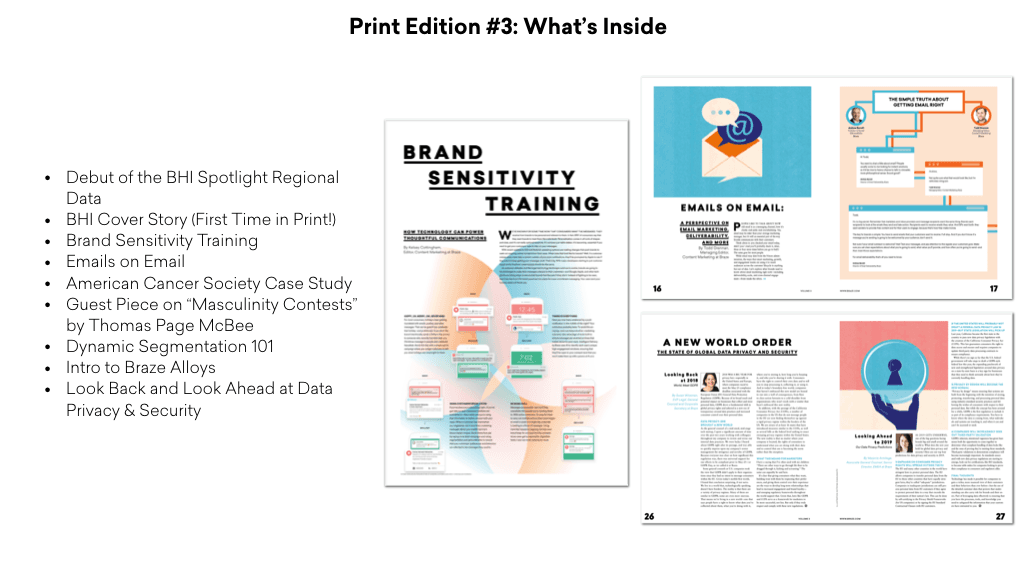
Grennan: With this third issue—well, I feel like we’ve cracked it, like we know just how long it takes to do each of these steps really down the day. We can build in a time buffer, based on things that have cropped up in the past, and this time it really was, well, I don’t want to say “A stress-free experience,” since anytime you’re reading a printed proof 12 times to check for errors, it’s not stress free. But I honestly feel so proud of the team for how much we've been able to master this and make it a process that's sustainable, repeatable, and not a major resource burden.
Fuentes: The Emails on Emails article is basically a bunch of conversations stitched together that was supposed to represent how an email chain about how marketing works today. Trying to fit it into the print edition, to stitch all of those conversations together in a way that it made sense for somebody to read them but then translating them to a print medium was also very interesting and very challenging. [It was novel] for me because I was involved both worlds [digital and print] of the piece. You can't add as much stuff that you do digitally because it would just be too much—overwhelming. Distilling that to something that made sense and was easy to read and easy to understand in a way that, this is how an email chain goes, was really a chance to reimagine it.
Grenier: [A year in,] we’ve done a great job of drawing in contributors within the Braze organization, but outside the content team, and the marketing team, we've found some real stars from the legal team, from the go-to-market team, from the partnership team, from the engineering team, and being able to partner, for example, with the engineering group in the establishment of their own ongoing content cadence one of the ways that we build for our own future success, as well as theirs.
Fuentes: When I first get a draft of an article, it’s interesting seeing all the different teams involved in creating and reviewing it. Some articles are more in-depth than others, but it’s always cools seeing that collaboration happen in a real-time kind of way. And it feels good working on that type of stuff because it's more like, "Oh, I never knew about this. This is a new aspect on the market that I didn't know about. Let's figure out how to visually convey that." I've learned a lot honestly. Just things that I never thought about before. It's like, "Oh, this article is really interesting. Glad they wrote it. It's nice to know about that.”
Cottingham: Having this really polished, robust, and very strategic content program has really reinstated and elevated us in our market and outside of our market. I truly believe that it has been kind of the bow on top of the package that is this rocket ship of a company, and I'm really proud of it.
Anything Else?
During Spring 2019, the Content Team found itself on the receiving end of some much-appreciated positive reinforcement from a couple of prestigious sources: Kelsey Cottingham received the 2019 Rising Star Award at The Drum Marketing Awards USA, while Perspectives was nominated for Best Branded Content Site (B2B) at the Digiday Content Marketing Awards.
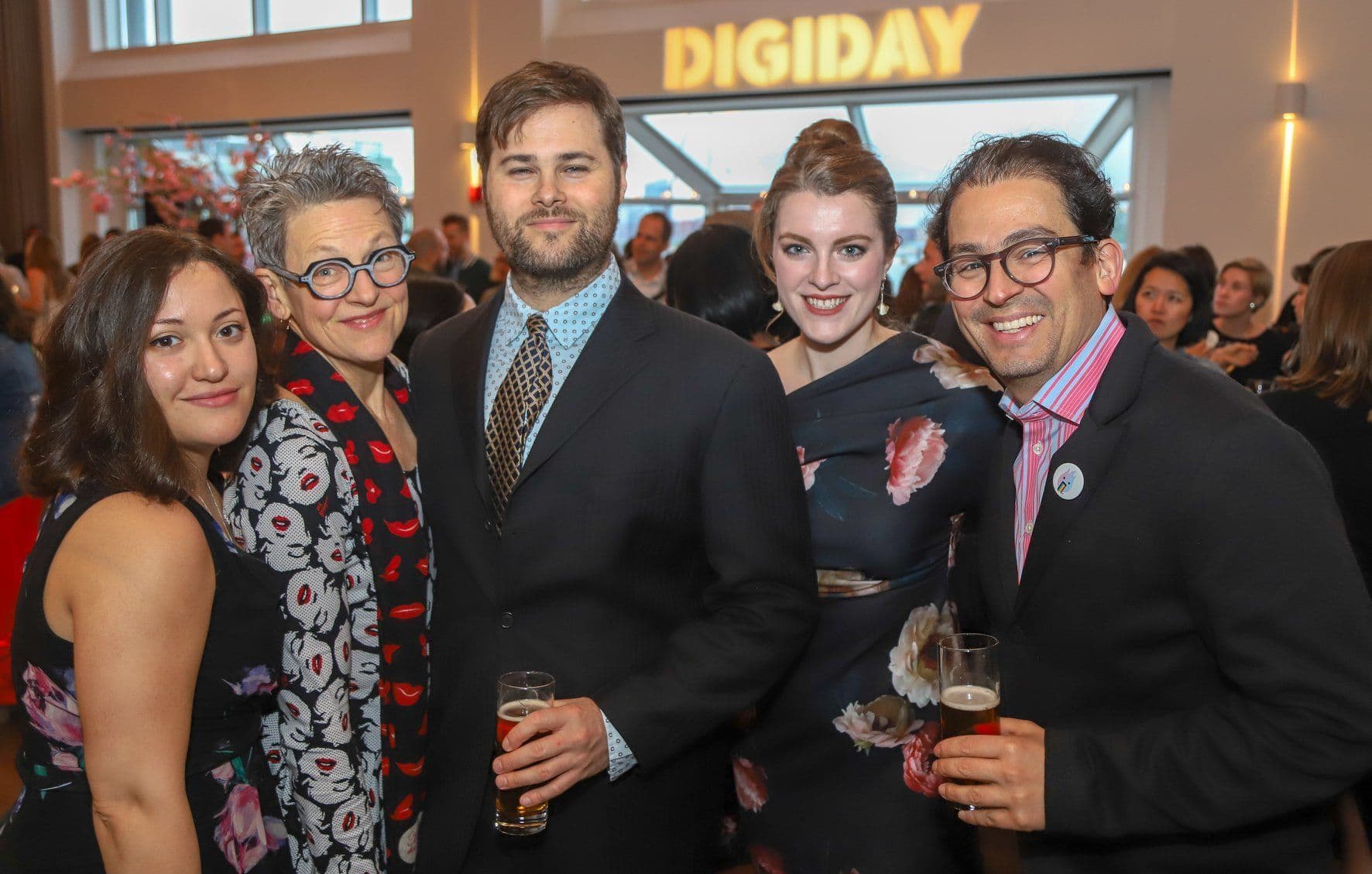
Want to see where the next year takes Perspectives while keeping up with the latest in customer engagement? Subscribe to Braze Magazine.
Related Tags
Be Absolutely Engaging.™
Sign up for regular updates from Braze.
Related Content
View the Blog
How behavioral marketing turns data into personalized experiences

Team Braze

Are you AI-savvy enough to survive? A wake-up call for CMOs

Team Braze

What are contextual bandits? The AI behind smarter, real-time personalization
